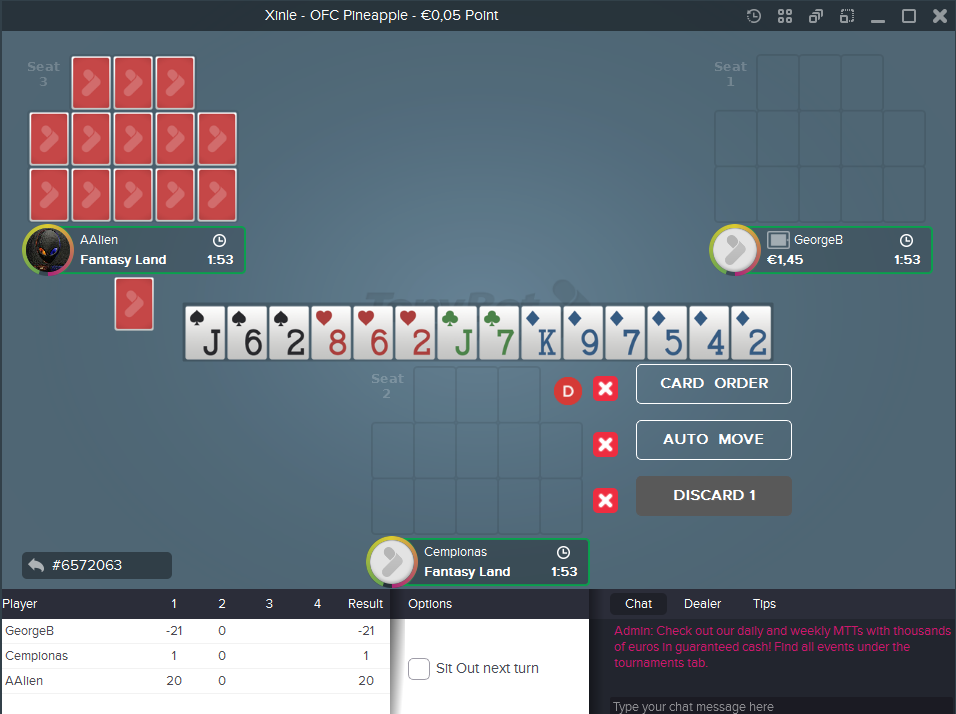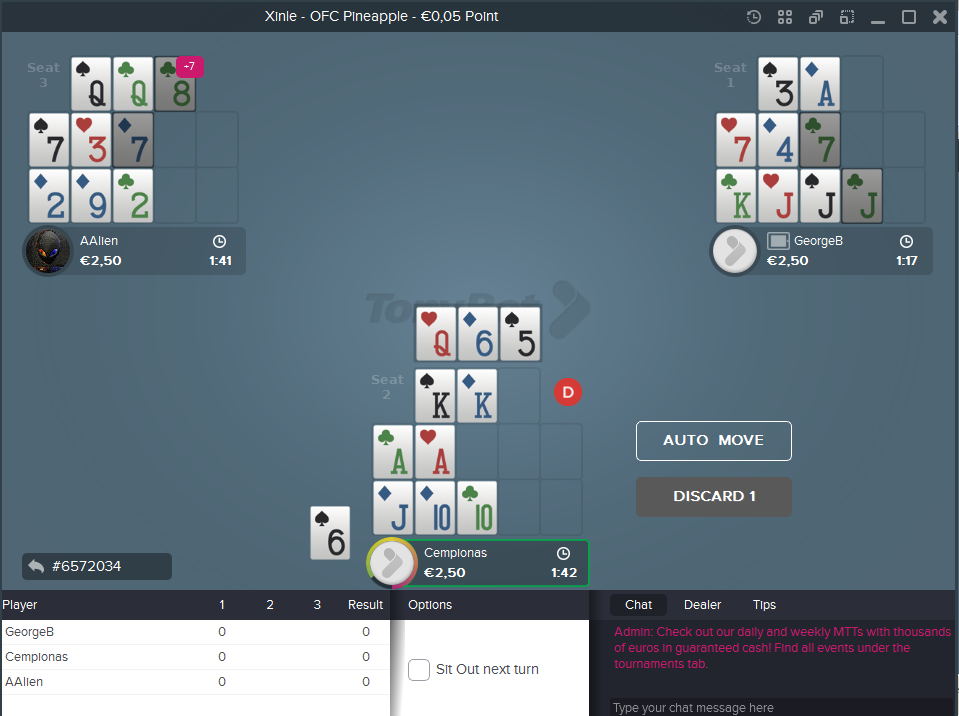
Pirmos 5 kortos. Labai didelis privalumas, kad mes šiuo atveju turim poziciją, tai didžiulis privalumas mums. Dabar pažvelkime į tai ką išdėstė mūsų oponentai. Žaidėjas „AAlien” dėjo kortas pirmas, neturėdamas jokios informacijos apie mūsų kortas ir pasirinko labai agresyvią liniją. Šiuo atveju jo pasirinkta linija nėra „bloga”, tačiau ji yra labai agresyvi ir oponentas turi labai didelį % sudėti neteisingą kombinaciją ir tiesiog sudegti. Šiuo atveju jis turi tik du būgnus ir nežino kiek jų jau yra išėję žaidime. Taip pat vidurys labai silpnas, jeigu vietoje 7 jis turėtų A arba K būtų daug geriau. Šiuo atveju aš pats pasirinkčiau tokią liniją: 2 9 / QQ7 ( 29 per vidurį, QQ7 apačioje). Priežastis saugesnės ir pasyvesnės linijos yra ta, kad jis žaidžia visiškai be jokios informacijos.
Žiūrėdami į pirmąjį oponentą mes jokiais būdais negalime teigti, kad jis padarė klaidą, galime tik matyti, kad jis pasirinko pačią agresyviausią liniją. Tačiau, žiūrėdami į antrąjį oponentą iškart matome fundamentalias kiniško pokerio klaidas. Nors atrodytų jo kortos gana padrikos ir tai yra prasta startinė ranka, tačiau pažvelkime detaliau. Visos jo turimos kortos yra 100% gyvos (kai jis dėliojo, dar nebuvo mūsų analizuojamo žaidėjo kortų). Taigi jo visos kortos gyvos, taip pat gyvos visos širdys jeigu jis norėtų dėti spalvą. Ir dar vienas labai svarbus momentas, kad jis turi K, ir kol kas jie visi yra gyvi. Taigi į ką reikia atkreipti dėmesį? Pirmiausia mes matome, kad pas pirmąjį oponentą yra padėtos dvi damos pačiame viršuje, tad labai mažėja tikimybė, kad „GeorgeB” ištrauks dar dvi damas, tad jo gyvas K labai puikiai tinka į viršutinį boksą. Taip pat, labai svarbu pastebėti, kad kai jis deda savo ranką dar nėra išėjęs nei vienas A, tad yra aukšta tikimybė, kad jam pavyks ištraukti su AA ir taip suformuoti saugią liniją su KK viršuje ir AA per vidurį. Tobuliausias dėjimas būtų. K pačiame viršuje, žaidžiant dėl fantazijos. Dar svarbu paminėti, kad surinkus KK mes ne tik gausime +8 taškus ir fantaziją, bet tuo pačiu ir laimėsime tašką prieš oponento damas ir galimybę ji scoopinti. Per vidurį reikėtų dėti 43, dvi gyvas mažas kortas, nes jos puikia tinka dviems poroms ir dar yra eilės galimybė. O apačioje palikti 7J yra puiki galimybė surinkti spalvą ar eilę ar dvi aukštesnes poras negu vidurinėje linijoje. Žiūrint į mūsų antrojo oponento išdėstymą, galime daryti prielaidą, kad jis nėra susipažinęs su pineapple pokerio subtilybėmis ir daugiau dėlioja kaip klasikinį kinišką pokerį, kur viršutinis boksas nėra toks svarbus kaip pineapple pokeryje.
Taigi prie stalo turime viena agresyvų žaidėją ir vieną visišką žuvį, kuris nelabai gaudosi, tad tikrai puiki vieta žaisti. Dabar pašnekėkime apie mūsų ranką. Ne tik, kad mes turime poziciją, bet mes dar ir gauname monstrą!! Labai smagu matyti tokią ranką. Vėl labai svarbus faktorius, kad mes turime A ir jie visi gyvi, tad didelė tikimybė, kad ištrauksime dar vieną. Tad, iškart A norisi dėti į vidurį. Padėję A į vidurį galime labai ramiai dėti KK į viršų. Esant gyviems visiems A yra labai aukšta tikimybė, kad mes saugiai užbaigsime savo ranką padėdami per vidurį AA arba dvi poras. Taip pat KK viršuje laimi prieš oponento QQ ir oponento 3. Tai papildomi du taškai mums ir galimybė scoopinti. Apačioje lieka JT kas yra irgi labai šaunu, nes turime eilės/spalvos galimybę ir taip pat surinkti dvi poras.
Taigi šiame dalinime, mes turime ir pozicijos pranašumą ir kortų pranašumą ir dar vieną žaidėją prie stalo, kuris nesupranta ką daro.
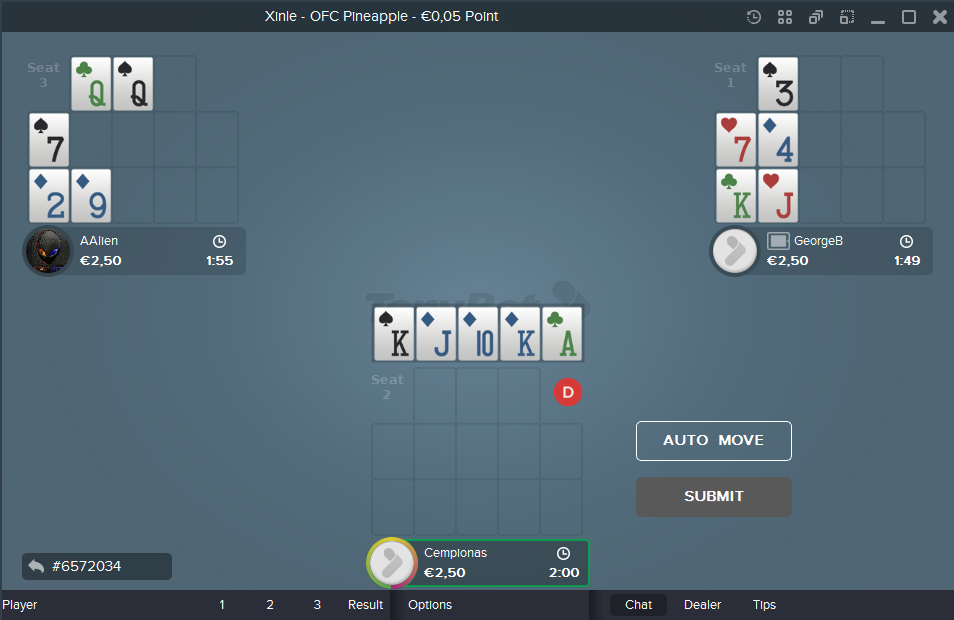
Taigi pirmosios mūsų trys kortos, kai reikia vieną išmesti, bet prieš žiūrint į jas apžvelkime ką gavo ir sudėjo mūsų oponentai. Pirmasis oponentas apačioje padėjo porą ir per vidurį gyvesnę mažą kortą. Jo linija labai aiški, jis stengiasi išsaugoti savo ranką, kad nesudegtų ir, kad gautų fantaziją. Tuo tarpu antrasis oponentas vėl „grybauja” J apačioje tikrai gerai, tačiau A viršuje jau rodo, kad oponentas nėra labai stiprus šiame žaidime. Problema ne tame, kad A viršuje būtų blogai, problema, kad pradžioje oponentas renkasi blogą liniją, o antrame dalinime deda A į viršų, tai rodo, kad pas žaidėją nėra loginio suvokimo apie žaidimą ir plano ką daryti vėlesniuose dalinimuose gavus tam tikras kortas.
Vienintelė blogybė pas jį yra ta, kad jis padėjo ir A ir J mums dvi būtinas kortas. Taigi mums lieka du A ir tik vienas J.
Tačiau mums ir vėl šypsosi likimas, gauname dvi mums gyvybiškai reikalingas kortas. A į vidurinę liniją, kuri garantuoja, kad nesudegsime su savo KK viršuje ir T apačioje. Dabar mums liko lengvoji dalis, mums užtenka bet kokios poros apačioje, kad nesudegti, surinkti +8 taškus ir gauti fantaziją.
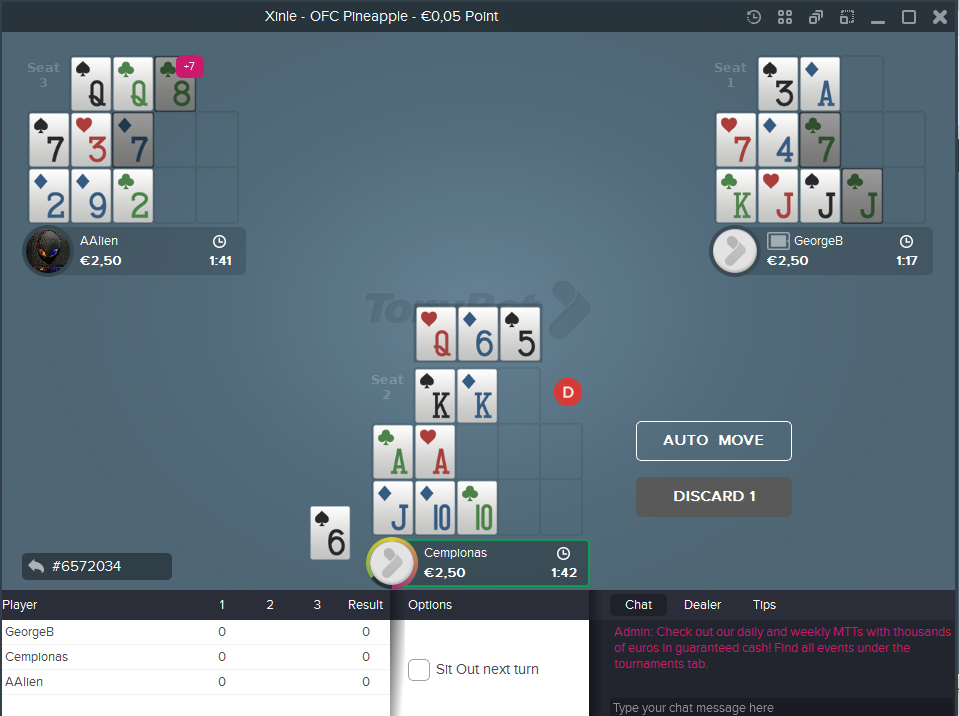
Gavome dar po tris kortas. Kadangi turime labai didelį pranašumą – poziciją, tad pradėkime vėl nuo oponentų kortų apžvalgos. Pirmasis oponentas padėjo 7/8. Labai svarbu, mes turime galvoti, ne tik ką ir kodėl oponentas deda, bet taip pat turime galvoti ir kokią kortą oponentas galėjo išmesti. Šiuo atveju vėl oponentas renkasi keistą sprendimą. Oponentas turi visiškai gyvą kortą: 8, kurią galėtų padėti į vidurinę liniją. Taip padidindamas savo šansus išgyventi. Dabar jam reikia ištraukti į vidurinę liniją arba 3 arba mažesnę porą už 9 (nes žemiausioje linijoje aukščiausia korta 9). Tad oponentui nėra nei menkiausios priežasties taip dėti. Dėdamas visiškai gyvą kortą viršuje, jis tik didina savo sudegimo tikimybę. Geras ženklas mums. Turint galvoje jo pasirinktą liniją yra labai didelę tikimybė, kad jis tiesiog sudegs šį raundą.
Antrasis oponentas šį kartą deda be klaidų, aišku kokios gali būti klaidos kai ištrauki tinkamas kortas 🙂 J apačioje į tripsus, apačioje lieka jam tik vienas autas ant pilnų namų. Ir pora viduryje. Nors ir oponentas pradėjo prastai, tačiau jo ranka yra saugi, ir jeigu pirmasis oponentas sudegs, tai jis iš jo jau uždirbs +6 taškus, neskaitant bonusų. Ir dar tikėtina mums nepraloš visų eilių, nes jo trečiasis J mums labai mažina tikimybę surinkti pilnus namus.
Taigi mūsų ranka. Dabar mūsų pagrindinis galvos skausmas yra, kaip sustiprinti apačią, kad nesudegtų ranką. Antrasis oponentas padėjo trečią J. Tai reiškia, mums apačioje liko tik 2 dešimtukai. Tad būtinai turime suteikti papildomų autų. Žiūrime į savo kortas: Q yra tik viena likus, nebetinka. 6 – dvi, ok viskas. 5 – visi trys gyvi, ideali situacija. Dedame apačioje visiškai gyvą kortą, kad būtų daugiau % ištraukti antrą porą.
Kadangi viršutinės eilutės jau niekaip nebegalėsime sustiprinti (jeigu padėsime KKK visada sudegsim). Dedame bet kurią kortą. Abi kortos nieko nekeičia nei mums nei oponentams, bet turiu įprotį dėti visada aukštesnę.
Taigi po 5+3+3 kortų esame labai geroje situacijoje. Dar gausime 6 kortas ir apačioje turime 5 autus ( T/T/5/5/5). Tuo tarpu didelė tikimybė, kad pirmasis oponentas degs, nes jam ne tik apačioje reikia ištraukti vieną iš 5 autų, bet dar ir viduryje, kur jam likę tik 2 autai (3/3). Aišku yra tikimybė, kad ištrauks porą per vidurį. Tačiau ta pora turės būti mažesnė negu antra pora apačioje.
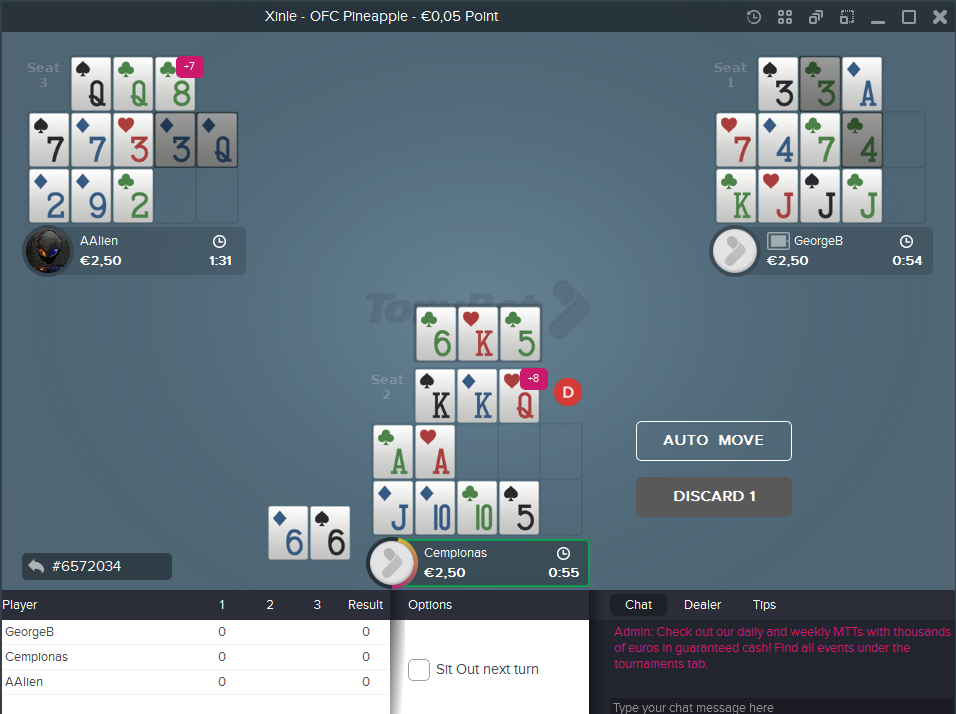
Prieš paskutinis kortų padalinimas. Pirmasis oponentas ištraukia vieną iš dviejų likusių 33. Jeigu šiuo ėjimu jam nebūtų pavykę to padaryti, jo situacija būtų itin komplikuota.
Tuo tarpu antrasis mūsų varžovas vėl daro klaidą. Čia labai tipinė pradedančiųjų klaida, kai dėliojamos kortos neatkreipiant dėmesio ką deda mūsų varžovai. Šiuo atveju ar GeorgeB viršuje turės //3/3/A// ar //2/3/A// visiškai nieko nekeičia. Už 33 porą viršuje jis negauna jokio bonuso ir pralošia abiems savo oponentams. Tad šiuo atveju reikia galvoti kažką kito.
Reikia atkreipti dėmesį, kad yra likęs vienas gyvas A. Tad jeigu GeorgeB surinktų viršuje AA3 jis ne tik gautų +9 taškus ir laimėtų prieš abu savo oponentus, bet dar ir gautų teisę dėlioti fantaziją. Tad užblokuodamas viršų jis praranda labai didelę galimybę savo ranką padaryti laiminčią. Kai kurie žaidėjai ginčysis su manimi, sakydami, kad jis pasilieka laisvas linijas dviems pilniems namams, tačiau jūs esate visiškai neteisus ir tuo labai lengva įsitikinti paskaičiavus autus. Apačioje jam yra gyva tik viena korta, vienas K (kai oponentas dėliojo, dar nebuvo mano kortų). Taigi. apačioje vienas autas ir galimybė surinkti +6 taškus ir laimėti prieš mus abu. Vidurinėje linijoje likę du autai, bet norint jais pasinaudoti ir uždirbti +12 taškų būtina apačioje ištraukti karalių. Tad norint surinkti du pilnus namus reikės ištraukti 1/1 ir 1/2 likusių kortų.
Tuo tarpu mūsų kortos vėl mums palankios, ištraukiame mums reikalingą 5, kuris praktiškai jau garantuoja, kad nesudegsime. Nors ir pralošiam prieš antrąjį oponentą pirmą ir antrą eiles, tačiau KK viršuje ir fantazija su kaupu tai kompensuoja. Prieš pirmąjį oponentą yra didelė tikimybė, kad jis sudegs ir mes surinksime +14 taškų +fantaziją.
Taigi 5 keliauja į apačią. Ką dėti per vidurį? Tokią kortą, kuri nesugadintų reikalo, nes iš paskutinio traukimo mes privalėsime padėti dvi kortas į vidurį, todėl būtina dėti labiau mirusią kortą, kad netyčia neištraukti antros poros per vidurį.
Taigi paskutinis dalinimas. Pirmasis oponentas ištraukia net ne vieną jam tinkamą kortą, o dvi ir laimi prieš mus abu toje eilėje ir dar gauna bonus +6 taškus. Tai nėra retenybė taip gerai ištraukti pabaigoje ypač jeigu jums yra likę daug gyvų kortų, tačiau vistiek oponentas šiuo atveju labai rizikavo. Antrasis oponentas jau nebesustiprina savo kombinacijos, tačiau galėtų dar suklysti padėdamas 4 per vidurį. Atrodo iš fantastikos srities, bet mažuose limituose žaidėjai sugeba padaryti net tokias klaidas ir sudegti kai jau atrodo, kad neįmanoma. Taigi sekantis žingsnis taškų skaičiavimas.

TonyBet Poker labai gražiai pateikia taškų skaičiavimą, matome kas laimi kiekvienoje linijoje. Kiek gauname už bonusus ir kiek gauname bendrai. Plačiau apie tai kaip skaičiuojami taškai kiniškame pokeryje galite rasti čia.
Taigi, nors ir startavome labai geroje pozicijoje ir pradžioje labai gerai krito kortos, tačiau užbaigėme tik su +1 tašku. Tačiau nėra ko liūdėti, pirmam oponentui sekėsi, tad ilgajame periode mes tikrai iš jo uždirbsime daugiau.
Taigi einame dėlioti fantazijos.
Fantazija – tai toks bonusas, kurį mes gauname, jeigu mums pavyksta žaidimo metu sudėti viršutinėje eilėje porą QQ arba aukštesnę kombinaciją ir nesudegti. Šiuo atveju tiek mes su KK, tiek mūsų oponentas su QQ abu gavome fantazijas. Dabar mes gauname visas 14 kortų iš karto į ranką ir turime jas sudėlioti į savo eiles. Toks kortų matymas iš karto suteikia labai didelį pranašumą prieš mūsų oponentus kurie dėlioja kortas paprastu būdu.
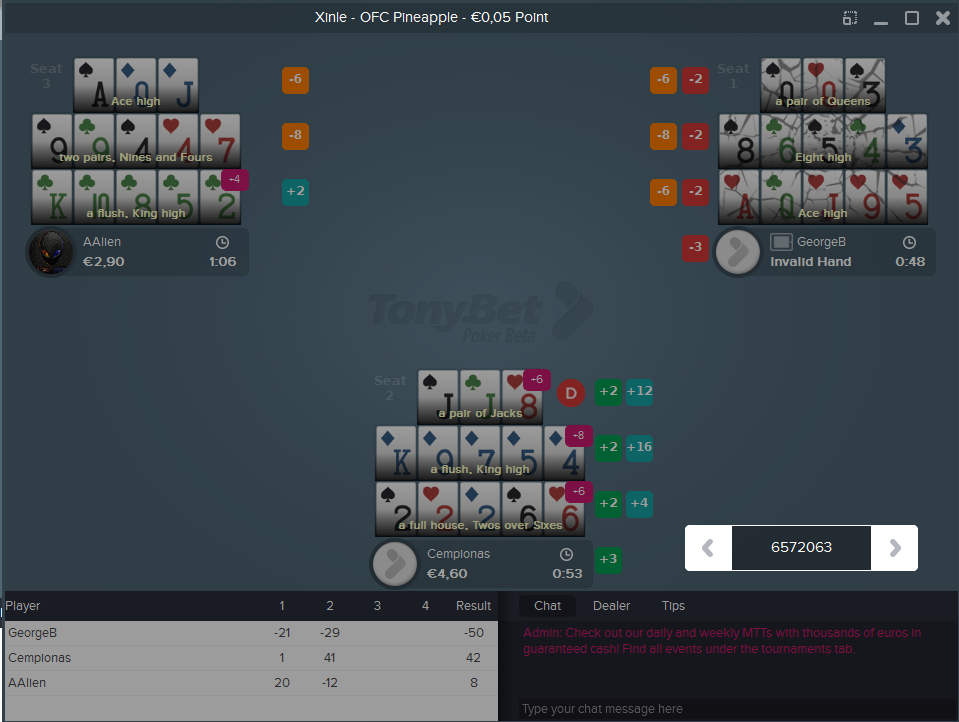
Štai galutiniai skaičiavimai po fantazijos. Labai nuskilo mums čia, kad pirmasis oponentas, kuris dėliojo fantaziją visur sudėjo mažesnes kombinacijas negu mes, todėl mes papildomai uždirbome iš jo +3 taškus. Šioje rankoje turėjome uždirbti dar daugiau taškų, bet pas antrąjį oponentą tiesiog pasibaigė pinigai. Tad mes neuždirbome maksimaliai tiek pinigų kiek galėjome.
Tai buvo antrasis straipsnis apie kinišką pokerį, kuri jums parengė „Brilijant”. Pirmajame straipsnyje mes apžvelgėm startinių penkių kortų išdėstymą, o sekančiame straipsnyje žvilgtelėsime į kiniško pokerio matematika ir kaip suskaičiuoti mums tinkančias kortas.




